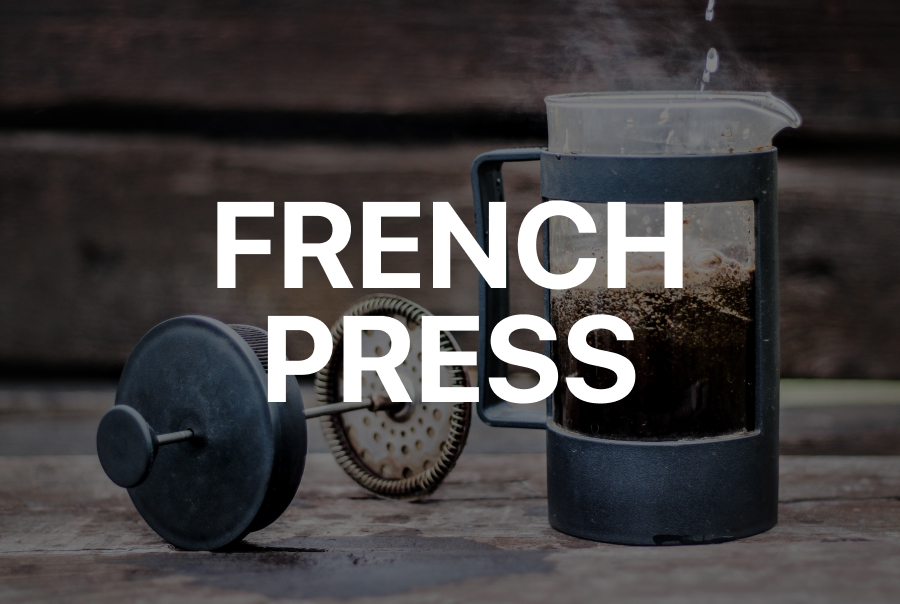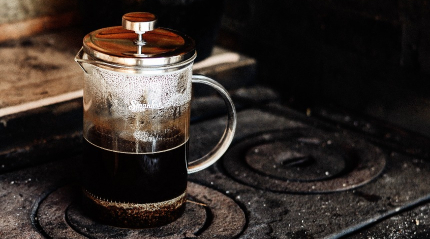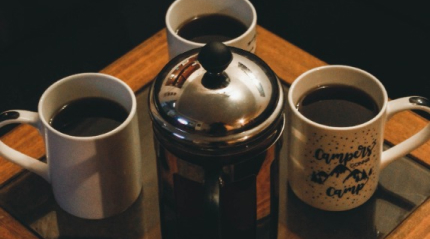
Even though instant coffee has been the norm for quite some time, a coffee culture revolution is on the rise, and the first step is learning how to use a French Press properly. However, those who are ready to go beyond the convenience of the instant jar will find that there is a world of rich, robust tastes waiting to be found.
French Press coffee has an irresistible appeal, and in this article, we'll show you how to make it. As coffee connoisseurs, we see the value in learning more about coffee and finding new ways to enjoy it, especially in a market where instant coffee is so prevalent. If you're looking for a break from the routine, a method to make your morning coffee into something special, go no further than the French Press.
In the following pages, we'll explore the fundamentals of French Press brewing, from choosing the best beans to the optimal brewing time. It's an adventure that'll blow your mind with its intense taste and aromatic scent. Get your favorite cup ready, because we're going on a journey where the commonplace becomes exceptional and the world of coffee is revealed to you. Thank you for visiting "Brewing Boldness: Mastering the French Press."
The French Press Unveiled: Brewing Coffee the Timeless Way
The French Press, often referred to as a Press Pot or plunger pot, is a classic and time-honored method of brewing coffee. Its elegance lies in its simplicity, allowing coffee enthusiasts to experience a full-bodied, aromatic cup of coffee with minimal equipment and fuss. In this section, we'll unveil the French Press, exploring what it is, how it works, its fascinating history, and the enduring charm of its design.
What is a French Press and How Does it Work?
At its core, a French Press is a cylindrical glass or stainless steel container fitted with a plunger and a metal or nylon mesh filter. The beauty of this device lies in its straightforward operation. Here's how it works:
- Brewing: Start by adding coarsely ground coffee beans to the French Press. The coffee-to-water ratio can be adjusted to your taste, but a common starting point is around 1:15 (1 part coffee to 15 parts water).
- Heating Water: Meanwhile, heat water to just below boiling (about 200°F or 93°C).
- Pouring Water: Pour the hot water over the coffee grounds, ensuring even saturation. Stir briefly to ensure all the coffee grounds are immersed.
- Steeping: Place the lid with the plunger on top, but don't press it down yet. Let the coffee steep for about 4 minutes. This steeping process allows the flavours to infuse into the water.
- Pressing: After the steeping time, slowly and steadily press the plunger down, using gentle pressure. The metal or nylon filter separates the coffee grounds from the liquid as you press.
- Serving: Your rich and flavourful coffee is ready to be poured and enjoyed. Be sure to serve it immediately to experience its full taste and aroma.
The History and Origin of the French Press
The French Press has a rich history that dates back to the 19th century. It was first patented by an Italian designer named Attilio Calimani in 1929, but its design and concept are believed to have been influenced by earlier coffee-brewing methods. However, its true rise to fame happened in France, which is why it bears the name "French Press."
Over the years, the design and materials of the French Press have evolved, but its fundamental principles have remained unchanged. It's a brewing method that emphasizes simplicity and purity, preserving the nuanced flavours and aromatic oils of coffee beans. The French Press continues to be celebrated for its timeless appeal and its ability to create coffee that captures the essence of its beans.

The Simple and Elegant Design of the French Press
The French Press embodies the concept that less can be more. Its design is remarkably simple, yet it offers a unique way to brew coffee. A typical French Press consists of a cylindrical glass or stainless steel container, a plunger, and a filter. What makes it truly elegant is its functional design: the plunger mechanism allows you to brew coffee and separate the grounds with ease. The transparency of the glass container also allows you to witness the coffee-making magic as it happens.
The French Press's design not only makes it a beautiful addition to any kitchen but also a conversation starter for coffee lovers. Its simplicity and timeless appearance have made it a beloved brewing method for generations.
Selecting the Best Coffee Beans
When it comes to mastering the art of French Press brewing, your choice of coffee beans is absolutely critical. The type of beans you select can make or break your coffee experience. In this section, we will delve into the significance of using high-quality coffee beans, explore the benefits of single origin coffee, and provide suggestions for the best coffee beans for French Press, taking into account factors like roast level and flavour profile.
Significance of Quality Coffee Beans
To truly appreciate the rich and bold flavours that the French Press method can bring to your cup, you need to start with high-quality coffee beans. Here's why it matters:
- Flavour Purity: High-quality beans often have a more distinct and pure flavour. The French Press brewing process allows these flavours to shine through, creating a coffee with depth and character.
- Freshness: Quality beans are usually fresher, which means they haven't been sitting on a shelf for extended periods. Freshness is vital for capturing the nuances of flavour.
- Roast Level Control: With premium beans, you have better control over the roast level. This is important because the roast level significantly impacts the taste of your coffee.
Single Origin Coffee
For those seeking a unique and authentic coffee experience, single origin beans are the way to go. Single origin coffee comes from a specific geographic location, often a single country, region, or even a particular farm. Here's why it's a great choice for your French Press:
- Distinctive flavours: Single origin beans carry the unique flavours of their specific growing region. They can offer anything from fruity and bright notes to earthy and chocolatey undertones.
- Terroir: Just like wine, coffee is influenced by its terroir, the environment in which it's grown. Single origin beans allow you to taste the terroir of a particular place.
- Story and Authenticity: Single origin coffee comes with a story. You can trace the beans back to their origin, learning about the people, culture, and traditions behind the coffee.
Suggesting the Best Coffee Beans for French Press
Now that you understand the importance of quality and the allure of single origin coffee, let's recommend some of the best coffee beans for French Press brewing:
- Brazilian Coffee: Brazil is known for its smooth, low-acid coffee. It's a great choice for those who prefer a mellow and nutty flavour profile.
- Ethiopian Coffee: If you want to explore a world of fruity and floral flavours, Ethiopian coffee, particularly from regions like Yirgacheffe, is an excellent choice.
- Colombian Coffee: Colombian coffee is often well-balanced with notes of caramel and a moderate level of acidity, making it a versatile option.
- Sumatran Coffee: Sumatran beans are famous for their earthy and full-bodied characteristics, perfect for those who like a more robust and spicy cup.
- Guatemalan Coffee: Guatemalan coffee offers a balanced profile with a touch of bright acidity and a chocolatey finish, appealing to a wide range of palates.
Remember, your choice of coffee beans should align with your personal taste preferences. Whether you prefer light or dark roast, single origin or a blend, the key is to explore and discover the flavours that delight your palate as you embark on your French Press coffee journey.
The Art of Grinding
In the world of coffee, one might not immediately associate grinding with an art form, but when it comes to the French Press, the right grind is an integral part of achieving that perfect cup. Let's delve into the art of grinding and understand why it's so crucial for French Press brewing.
Importance of Coffee Bean Grinding for French Press:
To begin, the process of grinding coffee beans plays a pivotal role in the French Press brewing method. When you're making coffee with this method, you're essentially creating a full immersion brew. In other words, the coffee grounds steep in hot water for an extended period, which allows for a rich and robust extraction of flavours.
The magic happens during this extraction, and the coffee grind size is the conductor of this symphony. If your grind is not suited for the French Press, it can either result in an underwhelming, weak cup of coffee or an overly bitter and gritty one. Hence, the right grind size is your gateway to unlocking the full potential of the French Press.
The Ideal Coarseness of Coffee Grounds:
So, what is the ideal coarseness of coffee grounds for French Press? It's coarse, and here's why. The coarse grind is akin to breadcrumbs or sea salt. It should have a slightly chunky texture, which allows the water to flow through while retaining the bigger coffee particles.
The coarseness serves two essential purposes. First, it prevents over-extraction, ensuring that your coffee doesn't turn bitter. Second, it allows for easy and efficient filtration when you press down the plunger, leaving you with a clean and sediment-free cup of coffee.
Impact of Grind Size on flavour and Aroma:
The grind size has a profound influence on the final flavour and aroma of your coffee. In the case of French Press, the coarse grind lets you savour the boldness and depth of the coffee's flavour profile. Since the grounds remain in contact with the water for a longer time, they release a broader spectrum of flavours.
If you were to use a finer grind for French Press, you might notice an overly bitter and muddy taste. The small particles would be over-extracted and lead to a less pleasant experience. On the other hand, a coarser grind accentuates the coffee's natural sweetness and subtleties, resulting in a well-balanced and full-bodied cup.
In essence, the art of grinding for French Press is about finding that Goldilocks zone – not too fine, not too coarse – just right. It's the balance between extracting the rich flavours and keeping the unwanted bitterness at bay.
To master the French Press, be sure to pay attention to your grind size, as it's one of the keys to unlocking the bold and delightful flavours that this brewing method has to offer.

Brewing Process Simplified
Brewing the perfect French Press coffee is an art, and here's how to master it:
- The Right Beans: Start with high-quality coffee beans. See our "Single Origin Coffee" guide for the best options.
- The Grind: Use a burr grinder to achieve a coarse grind, resembling breadcrumbs. This texture is ideal for the French Press.
- Water Temperature: Heat water to about 200°F (93°C), just below boiling, for the best extraction.
- Coffee-to-Water Ratio: A general rule of thumb is 1 ounce (28 grams) of coffee for every 15 ounces (450 ml) of water. Adjust to taste.
- Preheat the French Press: Rinse your French Press with hot water to ensure the brew stays warm.
- Add Coffee: Add the coffee grounds to the preheated French Press.
- Bloom: Pour a small amount of hot water (about double the coffee's weight) over the grounds to bloom them. Let it sit for 30 seconds and stir gently.
- Fill with Water: Pour the rest of the hot water over the coffee grounds, ensuring they are fully saturated.
- Stir: Give it a gentle stir to ensure even extraction.
- Place the Lid: Put the lid on the French Press with the plunger pulled all the way up.
- Brewing Time: Allow the coffee to steep for about 4 minutes. Adjust this time for your preferred strength.
- Plunge Slowly: After brewing, press the plunger down slowly to separate the grounds from the liquid.
- Serve and Enjoy: Pour your delicious French Press coffee into your favorite mug and savour the rich, bold flavours.
Tips and Tricks:
- Experiment with different beans and grinds to find your ideal flavour.
- Use a timer to ensure consistent brewing time.
- Consider a coffee scale for precise measurements.
- Explore various water-to-coffee ratios to suit your taste.
- For a smoother brew, you can use a metal mesh filter instead of the French Press's traditional filter.
Bold and Unique Coffee Blends
While mastering the French Press, consider the delightful world of coffee blends:
Crafted for the Press: Some coffee blends are specifically designed to shine in a French Press. They often feature bold and full-bodied flavours that complement this brewing method perfectly.
Coffee Bean Blends: If you're interested in exploring a wide variety of unique and flavourful blends, our detailed guide on coffee bean blends is just a click away.
Characteristics
These coffee blends typically consist of a well-balanced combination of beans from different origins, resulting in a complex flavor profile. You can expect rich, earthy, and full-bodied notes that stand up to the French Press's intensity.
A Touch of Decaf
For those who prefer the French Press experience without the caffeine jolt:
- Decaffeinated Options: Many coffee roasters offer decaffeinated beans that are suitable for French Press brewing.
- Decaffeination Methods: Various methods are used to remove caffeine from coffee beans, including the Swiss Water Process, CO2 extraction, and as is preferred by many Speciality Coffee Roasters due to the fact retains more flavor than other decaffeination processes in most cases, the all natural Sugarcane decaf process
- Enjoy the Boldness: Decaf coffee in a French Press can be a satisfying way to enjoy the boldness and aroma of your favorite brew without the stimulating effects.
With these insights, you'll not only master the French Press but also explore exciting coffee blends and savor the option of decaffeinated French Press brews.
Troubleshooting and Tips
Addressing Common Issues:
Even the most experienced French Press enthusiasts encounter issues from time to time. Here are a few common problems and how to solve them:
- Over-Extraction: If your coffee tastes bitter or too strong, you may have brewed it for too long. Adjust the brewing time and consider using a coarser grind.
- Under-Extraction: A weak and watery taste may indicate under-extraction. Try using hotter water and a finer grind to improve extraction.
- Sediment in Your Cup: If grounds are in your coffee, you can minimize this by gently stirring and letting the coffee settle before plunging. Alternatively, invest in a quality burr grinder to achieve more consistent grounds.
- Plunger Resistance: If the plunger is difficult to press down, check the grind size. It might be too fine, causing excessive resistance. Adjust your grinder accordingly.
Achieving the Best Results:
- To make the most of your French Press, consider the following tips:
- Use Fresh Beans: Always use freshly roasted beans to capture the best flavours.
- Water Quality: Opt for filtered water to avoid any unwanted flavours or minerals.
- Precision: Invest in a kitchen scale for precise coffee-to-water ratios.
- Preheating: Warm up your French Press with hot water before brewing to maintain the optimal temperature.
- Practice Patience: Allow the coffee to bloom (expand and release gases) for 30 seconds before pouring the rest of the water.
- Experiment: Don't be afraid to experiment with various beans, grind sizes, and brewing times to discover your perfect cup.

Cleaning and Maintenance
Proper Cleaning:
- Maintaining your French Press is crucial for both the taste of your coffee and the lifespan of your equipment.
- After pouring the coffee, disassemble the French Press for cleaning.
- Rinse the grounds out of the press with warm water.
- Use a soft sponge or brush to clean the plunger and the inside of the glass or stainless steel chamber. Be gentle to avoid damaging the components.
Importance of Regular Cleaning:
A clean French Press ensures that no coffee residues affect the taste of your next brew.
Stale coffee oils can build up and become rancid, negatively impacting your coffee's flavour.
Regular cleaning preserves the quality of your French Press and keeps it in optimal condition.
Tips for Maintenance:
- Proper maintenance can extend the lifespan of your French Press:
- Periodically check the mesh filter for any wear and tear. If damaged, replace it to maintain filtration quality.
- Store your French Press with the plunger fully up to prevent pressure on the filter, which can cause it to wear out.
- Avoid using abrasive cleaners or scrubbing pads that can scratch the glass or stainless steel.
Conclusion
In your quest to master the French Press, you'll find a unique and bold experience that transcends the convenience of instant coffee. The rich aromas and robust flavours will awaken your senses and make each morning a delight.
So, we encourage you to dive into the world of freshly brewed coffee with the French Press. With this elegant, uncomplicated brewing method, you'll not only savour a superior cup of coffee but also discover the joy of the journey itself. Happy brewing!



